Sphinginae subfamily
Sphingini tribe:
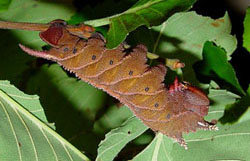 |
Ceratomia amyntor
WO,
the Elm Sphinx or Four-horned Sphinx
Caterpillars show both brown and green forms and are unmistakeable
due to four horns on the thorax (near the head).
Larvae feed on Elm (Ulmus), birch (Betula), basswood (Tilia), and
cherry (Prunus). |
 |
Note the pinkish-orange tail, spiracles outlined in red and the cream
stripes on the head.
The dramatic color change from the dorsal
yellow-green to the lateral light greyish-blue is not always
as intense as in this image.
|
 |
This caterpillar is also without the anal horn and feeds on pines.
The long stripes and reddish brown afford great camouflage.
|
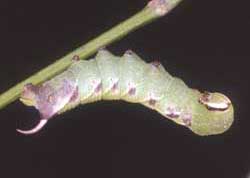
|
Sphinx canadensis
USGS,
Sphinx canadensis, the Canadian Sphinx.
This species is not common at lights, and is not
often reported anywhere,
but is present in Kennebec County.
Larval host may be exclusively black ash (Fraxinus nigra).
Variable appearance but always with granulous horn.
|
 |
Sphinx chersis
WO,
the Northern Ash Sphinx or Great Ash Sphinx
Note pale blue horn and the creamy-white stripes on head.
The yellow form has a red horn.
Larval hosts are ash, lilac, privet, cherry and quaking aspen.
|
 |
Larvae hide in the day and feed primarily on cherry, plum, and apple
at night. Larvae have been found on Amelanchier nantuckensis
in Massachusetts and have been reared to pupation in Michigan on
Prunus serotina. Note purple oblique lines.
|
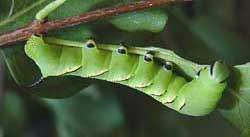 |
In the final instar, the black on the head, lateral lines, horn and on abdominal
legs is diagnostic. Larvae feed primarily on lilac and fringe.
|
 |
Sphinx luscitiosa
WO,
the Canadian Sphinx or
Clemen's Sphinx
This one is reported from Richmond and from northeastern New
Jersey into southern Canada.
|
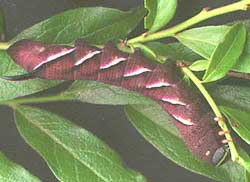 |
If you have blueberries in the woods, then you probably have the
Poecila Sphinx.
The green form is more common.
|
Smerinthini Tribe:
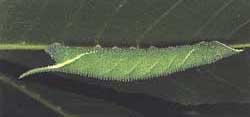 |
Amorpha juglandis larvae feed upon Walnut and butternut (Juglans),
hickory (Carya), alder (Alnus), beech (Fagus),
hazelnut (Corylus), and hop-hornbeam (Ostrya).
|
 |
Pachysphinx modesta
WO,
the Modest Sphinx or Poplar Sphinx
This moth is not officially recorded in Kennebec County. It is fond
of poplars and
willows and is most likely present.
|
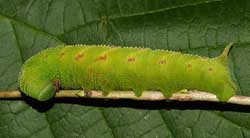 |
It would be more common
to the south and is a relatively uncommon species.
Only rarely are they seen in Maine. Blueberry and huckleberry (Vaccinium), cherries (Prunus) and
willows (Salix) are favorite larval foodplants.
|
 |
Larvae accept willows, birches, and cherries.
I have also found them in the wild on oak in eastern Canada.
|
 |
Wild cherry species are the favorites as larval foodplants, but eggs
will also be deposited on birches and other forest trees.
There are varying degrees in the amount of red markings along the sides.
|
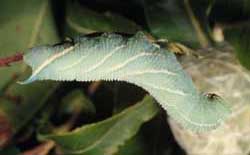 |
Larvae feed upon many forest trees including birches and cherries,
but are expecially fond of poplars and willows. Red markings on sides
vary greatly from specimen to specimen.
|
 |
Smerinthus cerisyi
WO,
Cerisy's Sphinx;
Cerisyi larvae greatly resemble modesta larvae, both being pale
green, with granular skin, pale lateral diagonal lines, faint red
spiracular circles, and very pale longitudinal lines running from the
head to a more pronounced anal diagonal line.
Larvae have green heads bounded dorsally with a pale yellow
inverted "V".
|
Macroglossinae subfamily
Dilophonotini tribe:
 |
Hemaris thysbe
WO, the Hummingbird Clearwing
There is also an orangey-pink prepupal form. The lateral line runs
from S1 to the blue horn.
Hemaris thysbe larvae feed on viburnum and related plants.
|
 |
Hemaris diffinis
WO, the
Snowberry Clearwing or Bumblebee Moth
Larval host plants include Snowberry (Symphoricarpos),
honeysuckle (Lonicera), Coralberry, viburnums, Blue Dogbane
(Apocynum) and dwarf bush honeysuckle (Diervilla lonicera).
Horn is black with a yellow base.
|
 |
Hemaris gracilis WO, the
Slender Clearwing or Graceful Clearwing
Hemaris gracilis is distinguished from similar species by a pair of
red-brown bands on the undersides of the thorax, which varies from
green to yellow-green dorsally and sometimes brown with white
underneath. They have a red abdomen. unlikely
|
Macroglossini tribe:
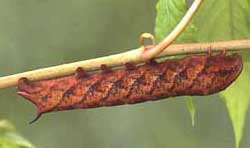 |
In additon to Virginia creeper larvae accept Grape (Vitis),
ampelopsis (Ampelopsis), and cayenne pepper (Capsicum).
Larvae are green until the final instar.
|
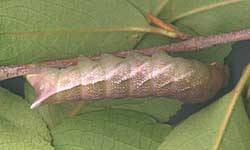 |
Larvae feed on Azalea and Viburnum and progress very rapidly. The
larva to the left on Viburnum cassinoides is getting ready to
pupate. Color change from green to light burgundy-brown indicates
pupation is imminent.
|
 |
Hyles gallii
WO, the Bedstraw Hawk Moth
or Gallium Sphinx
Larvae come in black and in brown forms and often feed on
Epilobium (fireweed).
|
 |
Proserpinus flavosfasciata
WO,
Yellow-banded Day Sphinx:
Penultimate instar is pale green with pair of pale, dorsolateral lines running from head to base of short caudal horn.
Last instar is brown-black with numerous black dots; caudal horn replaced by a black button surrounded by whitish band edged with black.
|
|
|
